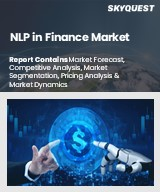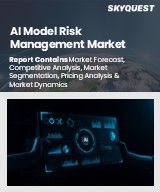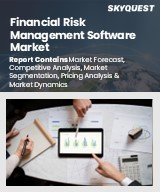
|
시장보고서
상품코드
1623799
리스크 관리용 AI 시장 규모, 점유율, 성장 분석 : 컴포넌트별, 도입 모델별, 리스크별, 용도별, 최종 용도별, 지역별 - 산업 예측(2025-2032년)AI For Risk Management Market Size, Share, Growth Analysis, By Component (Software, Services), By Deployment Model (On-Premises, Cloud), By Risk, By Application, By End Use, By Region - Industry Forecast 2025-2032 |
||||||
세계의 리스크 관리용 AI 시장 규모는 2023년 53억 달러로 평가되었고, 예측 기간(2025-2032년) 동안 11.1%의 연평균 복합 성장률(CAGR)로 2024년 58억 9,000만 달러에서 2032년 136억 7,000만 달러로 성장할 것으로 예상됩니다.
AI는 아이디어 도출, 데이터 소싱, 모델 개발, 모니터링 등 다양한 용도로 활용도가 높아 리스크 관리에 도입되는 사례가 증가하고 있습니다. 기존 프레임워크와 가치관에 부합하는 평가를 수행함으로써 조직 고유의 규제 리스크와 풍문 리스크 식별을 강화합니다. AI는 위협 분석, 위험 감소, 부정행위 감지, 데이터 분류를 용이하게 하고, 머신러닝 엔진을 활용하여 방대한 데이터세트를 분석하여 사전 예방적 리스크 관리를 위한 실시간 예측 모델을 생성합니다. 실시간 예측 모델을 생성합니다. 그러나 이 산업의 성장은 대량의 데이터 처리에 따른 높은 비용과 데이터 프라이버시 및 보호에 대한 심각한 우려로 인해 클라우드 서비스에는 강력한 보안 조치가 필요하며, 클라우드 서비스에는 강력한 보안 조치가 필요합니다.
목차
서론
- 조사의 목적
- 조사 범위
- 정의
조사 방법
- 정보 조달
- 2차 데이터와 1차 데이터 방법
- 시장 규모 예측
- 시장의 전제조건과 제한
개요
- 세계 시장 전망
- 공급과 수요의 동향 분석
- 부문별 기회 분석
시장 역학과 전망
- 시장 개요
- 시장 규모
- 시장 역학
- 촉진요인과 기회
- 억제요인과 과제
- Porter의 산업 분석
주요 시장 인사이트
- 주요 성공 요인
- 경쟁의 정도
- 주요 투자 기회
- 시장 에코시스템
- 시장의 매력 지수(2024년)
- PESTEL 분석
- 거시경제 지표
- 밸류체인 분석
- 가격 분석
- 기술 분석
- 규제 분석
- 사례 연구 분석
- 특허 분석
리스크 관리용 AI 시장 규모 : 컴포넌트별
- 시장 개요
- 소프트웨어
- 서비스
- 프로
- 관리
리스크 관리용 AI 시장 규모 : 도입 모델별
- 시장 개요
- 온프레미스
- 클라우드
리스크 관리용 AI 시장 규모 : 리스크별
- 시장 개요
- 모델 리스크
- 운영 리스크
- 컴플라이언스 리스크
- 평판 리스크
- 전략 리스크
리스크 관리용 AI 시장 규모 : 용도별
- 시장 개요
- 신용 리스크 관리
- 부정행위 탐지와 방지
- 알고리즘 트레이딩
- 예지보전
- 기타
리스크 관리용 AI 시장 규모 : 최종 용도별
- 시장 개요
- BFSI
- IT 및 통신
- 헬스케어
- 자동차
- 소매업과 E-Commerce
- 제조업
- 정부와 방위
- 기타
리스크 관리용 AI 시장 규모
- 북미
- 미국
- 캐나다
- 유럽
- 독일
- 스페인
- 프랑스
- 영국
- 이탈리아
- 기타 유럽 지역
- 아시아태평양
- 중국
- 인도
- 일본
- 한국
- 기타 아시아태평양
- 라틴아메리카
- 브라질
- 기타 라틴아메리카 지역
- 중동 및 아프리카
- GCC 국가
- 남아프리카공화국
- 기타 중동 및 아프리카
경쟁 정보
- 상위 5사의 비교
- 주요 기업의 시장 포지셔닝(2024년)
- 주요 시장 기업이 채택한 전략
- 시장의 최근 동향
- 기업의 시장 점유율 분석(2024년)
- 주요 기업의 기업 개요
- 회사 개요
- 제품 포트폴리오 분석
- 부문별 점유율 분석
- 매출의 전년대비 비교(2022-2024)
주요 기업 개요
- Alteryx(US)
- Apparity(US)
- Axioma(US)
- Databricks(US)
- DataRobot(US)
- Empowered Systems(US)
- FICO(US)
- Friss(Netherlands)
- Google(US)
- IBM(US)
- Kx Systems(US)
- MathWorks(US)
- Microsoft(US)
- Quantiphi(US)
- RiskLens(US)
- SAS(US)
- TIBCO Software(US)
- ValidMind(US)
- Yields.io(Belgium)
- Zest AI(US)
결론과 권장사항
KSA 25.02.04Global AI For Risk Management Market size was valued at USD 5.3 billion in 2023 and is poised to grow from USD 5.89 billion in 2024 to USD 13.67 billion by 2032, growing at a CAGR of 11.1% during the forecast period (2025-2032).
AI is increasingly being adopted for risk management due to its versatility in applications such as ideation, data sourcing, model development, and monitoring. It enhances the identification of regulatory and reputational risks unique to organizations by conducting assessments aligned with existing frameworks and values. Effective risk management depends on selecting the right data, which can be refined through previous assessments suitable for AI processing. AI facilitates threat analysis, risk reduction, fraud detection, and data classification, leveraging machine learning engines to analyze vast datasets and generate real-time predictive models for proactive risk management. However, the industry's growth may be hindered by high costs associated with processing large data volumes, alongside critical concerns surrounding data privacy and protection, necessitating robust security measures for cloud services.
Top-down and bottom-up approaches were used to estimate and validate the size of the Global Ai For Risk Management market and to estimate the size of various other dependent submarkets. The research methodology used to estimate the market size includes the following details: The key players in the market were identified through secondary research, and their market shares in the respective regions were determined through primary and secondary research. This entire procedure includes the study of the annual and financial reports of the top market players and extensive interviews for key insights from industry leaders such as CEOs, VPs, directors, and marketing executives. All percentage shares split, and breakdowns were determined using secondary sources and verified through Primary sources. All possible parameters that affect the markets covered in this research study have been accounted for, viewed in extensive detail, verified through primary research, and analyzed to get the final quantitative and qualitative data.
Global Ai For Risk Management Market Segmental Analysis
Global AI For Risk Management Market is segmented by component, deployment model, risk, application, end use and region. Based on component, the market is segmented into software and services. Based on deployment model, the market is segmented into on-premises and cloud. Based on risk, the market is segmented into model risk, operational risk, compliance risk, reputational risk and strategic risk. Based on application, the market is segmented into credit risk management, fraud detection and prevention, algorithmic trading, predictive maintenance and others. Based on end use, the market is segmented into BFSI, IT & telecom, healthcare, automotive, retail and e-commerce, manufacturing, government and defense and others. Based on region, the market is segmented into North America, Europe, Asia Pacific, Latin America and Middle East & Africa.
Driver of the Global Ai For Risk Management Market
The Global AI for Risk Management market is significantly propelled by the increasing demand for efficient solutions that enhance market growth. A crucial component contributing to this is threat intelligence data, which offers insights into various attacker sources, indicators of compromise, and behavioral trends associated with cloud account usage and attacks on diverse cloud services. By utilizing machine learning, organizations can compile and analyze these threat intelligence feeds on a large scale. Furthermore, this data is refined to develop models focused on likelihood and predictability, enabling companies to better anticipate and mitigate risks effectively.
Restraints in the Global Ai For Risk Management Market
The Global AI for Risk Management market faces several significant restraints that could impede its growth. One of the primary challenges is the high level of privacy concerns associated with handling sensitive data. For startups and emerging companies, developing tailored AI solutions can be prohibitively expensive, even when utilizing cloud-native services, due to the substantial costs involved in processing large volumes of data. In addition to the financial burden, the pressing issues of data privacy and protection present formidable obstacles to the adoption of AI and machine intelligence technologies, which may deter investment and innovation in this sector.
Market Trends of the Global Ai For Risk Management Market
The Global AI for Risk Management market is undergoing a transformative trend characterized by the integration of blockchain technology, enhancing data security and transaction tracking. This secure framework enables organizations to efficiently monitor and manage risks, thereby improving overall risk governance. Concurrently, there is a heightened emphasis on ethical considerations in AI-driven risk management solutions, addressing concerns surrounding algorithmic bias and ensuring fairness. As businesses strive for transparency and accountability, the fusion of blockchain and ethical AI practices is positioning itself as a key driver for innovation and trust in the risk management landscape, fostering sustainable growth in this evolving market.
Table of Contents
Introduction
- Objectives of the Study
- Scope of the Report
- Definitions
Research Methodology
- Information Procurement
- Secondary & Primary Data Methods
- Market Size Estimation
- Market Assumptions & Limitations
Executive Summary
- Global Market Outlook
- Supply & Demand Trend Analysis
- Segmental Opportunity Analysis
Market Dynamics & Outlook
- Market Overview
- Market Size
- Market Dynamics
- Drivers & Opportunities
- Restraints & Challenges
- Porters Analysis
- Competitive rivalry
- Threat of substitute
- Bargaining power of buyers
- Threat of new entrants
- Bargaining power of suppliers
Key Market Insights
- Key Success Factors
- Degree of Competition
- Top Investment Pockets
- Market Ecosystem
- Market Attractiveness Index, 2024
- PESTEL Analysis
- Macro-Economic Indicators
- Value Chain Analysis
- Pricing Analysis
- Technology Analysis
- Regulatory Analysis
- Case Study Analysis
- Patent Analysis
Global AI For Risk Management Market Size by Component & CAGR (2025-2032)
- Market Overview
- Software
- Services
- Professional
- Managed
Global AI For Risk Management Market Size by Deployment Model & CAGR (2025-2032)
- Market Overview
- On-Premises
- Cloud
Global AI For Risk Management Market Size by Risk & CAGR (2025-2032)
- Market Overview
- Model Risk
- Operational Risk
- Compliance Risk
- Reputational Risk
- Strategic Risk
Global AI For Risk Management Market Size by Application & CAGR (2025-2032)
- Market Overview
- Credit Risk Management
- Fraud Detection and Prevention
- Algorithmic Trading
- Predictive Maintenance
- Others
Global AI For Risk Management Market Size by End Use & CAGR (2025-2032)
- Market Overview
- BFSI
- IT & Telecom
- Healthcare
- Automotive
- Retail and E-Commerce
- Manufacturing
- Government and Defense
- Others
Global AI For Risk Management Market Size & CAGR (2025-2032)
- North America (Component, Deployment Model, Risk, Application, End Use)
- US
- Canada
- Europe (Component, Deployment Model, Risk, Application, End Use)
- Germany
- Spain
- France
- UK
- Italy
- Rest of Europe
- Asia Pacific (Component, Deployment Model, Risk, Application, End Use)
- China
- India
- Japan
- South Korea
- Rest of Asia-Pacific
- Latin America (Component, Deployment Model, Risk, Application, End Use)
- Brazil
- Rest of Latin America
- Middle East & Africa (Component, Deployment Model, Risk, Application, End Use)
- GCC Countries
- South Africa
- Rest of Middle East & Africa
Competitive Intelligence
- Top 5 Player Comparison
- Market Positioning of Key Players, 2024
- Strategies Adopted by Key Market Players
- Recent Developments in the Market
- Company Market Share Analysis, 2024
- Company Profiles of All Key Players
- Company Details
- Product Portfolio Analysis
- Company's Segmental Share Analysis
- Revenue Y-O-Y Comparison (2022-2024)
Key Company Profiles
- Alteryx (US)
- Company Overview
- Business Segment Overview
- Financial Updates
- Key Developments
- Apparity (US)
- Company Overview
- Business Segment Overview
- Financial Updates
- Key Developments
- Axioma (US)
- Company Overview
- Business Segment Overview
- Financial Updates
- Key Developments
- Databricks (US)
- Company Overview
- Business Segment Overview
- Financial Updates
- Key Developments
- DataRobot (US)
- Company Overview
- Business Segment Overview
- Financial Updates
- Key Developments
- Empowered Systems (US)
- Company Overview
- Business Segment Overview
- Financial Updates
- Key Developments
- FICO (US)
- Company Overview
- Business Segment Overview
- Financial Updates
- Key Developments
- Friss (Netherlands)
- Company Overview
- Business Segment Overview
- Financial Updates
- Key Developments
- Google (US)
- Company Overview
- Business Segment Overview
- Financial Updates
- Key Developments
- IBM (US)
- Company Overview
- Business Segment Overview
- Financial Updates
- Key Developments
- Kx Systems (US)
- Company Overview
- Business Segment Overview
- Financial Updates
- Key Developments
- MathWorks (US)
- Company Overview
- Business Segment Overview
- Financial Updates
- Key Developments
- Microsoft (US)
- Company Overview
- Business Segment Overview
- Financial Updates
- Key Developments
- Quantiphi (US)
- Company Overview
- Business Segment Overview
- Financial Updates
- Key Developments
- RiskLens (US)
- Company Overview
- Business Segment Overview
- Financial Updates
- Key Developments
- SAS (US)
- Company Overview
- Business Segment Overview
- Financial Updates
- Key Developments
- TIBCO Software (US)
- Company Overview
- Business Segment Overview
- Financial Updates
- Key Developments
- ValidMind (US)
- Company Overview
- Business Segment Overview
- Financial Updates
- Key Developments
- Yields.io (Belgium)
- Company Overview
- Business Segment Overview
- Financial Updates
- Key Developments
- Zest AI (US)
- Company Overview
- Business Segment Overview
- Financial Updates
- Key Developments



















